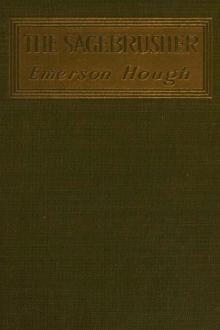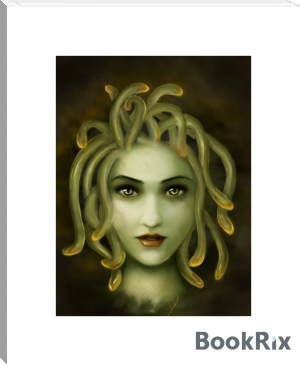The Story of the Outlaw by Emerson Hough (most read books in the world of all time .TXT) 📖

- Author: Emerson Hough
- Performer: -
Book online «The Story of the Outlaw by Emerson Hough (most read books in the world of all time .TXT) 📖». Author Emerson Hough
This murder was a nail in the Kid's coffin, for Carlyle was well liked at White Oaks. By this time the toils began to tighten in all directions. The United States Government had a detective, Azariah F. Wild, in Lincoln county. Pat Garrett had now just been elected sheriff, and was after the outlaws. Frank Stewart, a cattle detective, with a party of several men, was also in from the Canadian country looking for the Kid and his gang for thefts committed over to the east of Lincoln county, across the lines of Texas and the Neutral Strip. The Kid at this time wrote to Captain J. C. Lea, at Roswell, that if the officers would leave him alone for a time, until he could get his stuff together, he would pull up and leave the country, going to old Mexico, but that if he was crowded by Garrett or any one else, he surely would start in and do some more killing. This did not deter Garrett, who, with a posse made up of Chambers, Barney Mason, Frank Stewart, Juan Roibal, Lee Halls, Jim East, "Poker Tom," "Tenderfoot Bob," and "The Animal," with others, all more or less game, or at least game enough to go as far as Fort Sumner, at length rounded up the Kid, and took him, Billy Wilson, Tom Pickett and Dave Rudabaugh; Garrett killing O'Folliard and Bowdre.
Pickett was left at Las Vegas, as there was no United States warrant out against him. Rudabaugh was tried later for robbing the United States mails, later tried for killing his jailer, and was convicted and sentenced to be hung; but once more escaped from the Las Vegas jail and got away for good. The Kid was not so fortunate. He was tried at Mesilla, before Judge Warren H. Bristol, the same man whose life he was charged with attempting in 1879. Judge Bristol appointed Judge Ira E. Leonard, of Lincoln, to defend the prisoner, and Leonard got him acquitted of the charge of killing Bernstein on the reservation. He was next tried, at the same term of court, for the killing of Sheriff William Brady, and in March, 1881, he was convicted under this charge and sentenced to be hanged at Lincoln on May 13, 1881. He was first placed under guard of Deputies Bob Ollinger and Dave Woods, and taken across the mountains in the custody of Sheriff Garrett, who received his prisoner at Fort Stanton on April 21.
Lincoln county was just beginning to emerge from savagery. There was no jail worth the name, and all the county could claim as a place for the house of law and order was the big store building lately owned by Murphy, Riley & Dolan. It was necessary to keep the Kid under guard for the three weeks or so before his execution, and Sheriff Garrett chose as the best available material Bob Ollinger and J. W. Bell, a good, quiet man from White Oaks, to act as the death watch over this dangerous man, who seemed now to be nearly at the end of his day.
Against Bob Ollinger the Kid cherished an undying hatred, and longed to kill him. Ollinger hated him as much, and wanted nothing so much as to kill the Kid. He was a friend of Bob Beckwith, whom the Kid had killed, and the two had always been on the opposite sides of the Lincoln county fighting. Ollinger taunted the Kid with his deeds, and showed his own hatred in every way. There are many stories about what now took place in this old building at the side of bloody little Lincoln street. A common report is that in the evening of April 28, 1881, the Kid was left alone in the room with Bell, Ollinger having gone across the street for supper; that the Kid slipped his hands out of his irons—as he was able to do when he liked, his hands being very small—struck Bell over the head with his shackles while Bell was reading or was looking out of the window, later drawing Bell's revolver from its scabbard and killing him with it. This story is not correct. The truth is that Bell took the Kid, at his request, into the yard back of the jail; returning, the Kid sprang quickly up the stairs to the guard-room door, as Bell turned to say something to old man Goss, a cook, who was standing in the yard. The Kid pushed open the door, caught up a revolver from a table, and sprang to the head of the stairs just as Bell turned the angle and started up. He fired at Bell and missed him, the ball striking the left-hand side of the staircase. It glanced, however, and passed through Bell's body, lodging in the wall at the angle of the stair. Bell staggered out into the yard and fell dead. This story is borne out by the reports of Goss and the Kid, and by the bullet marks. The place is very familiar to the author, who at about that time practiced law in the same building, when it was used as the Court House, and who has also talked with many men about the circumstances.
The Kid now sprang into the next room and caught up Ollinger's heavy shotgun, loaded with the very shells Ollinger had charged for him. He saw Ollinger coming across the street, and just as he got below the window at the corner of the building the Kid leaned over and said, coolly and pleasantly, "Hello, old fellow!" The next instant he fired and shot Ollinger dead. He then walked around through the room and out upon the porch, which at that time extended the full length of the building, and, coming again in view of Ollinger's body, took a second deliberate shot at it. Then he broke the gun across the railing and threw the pieces down on Ollinger's body. "Take that to hell with you," he said coolly. Then, seeing himself free and once more king of Lincoln street, he warned away all who would approach, and, with a file which he compelled Goss to bring to him, started to file off one of his leg irons. He got one free, ordered a bystander to bring him a horse, and at length, mounting, rode away for the Capitans, and so to a country with which he had long been familiar. At Las Tablas he forced a Mexican blacksmith to free him of his irons. He sent the horse, which belonged to Billy Burt, back by some unknown friend the following night.
He was now again on his native heath, a desperado and an outlaw indeed, and obliged to fight for his life at every turn; for now he knew the country would turn against him, and, as he had been captured through information furnished through supposed friends, he knew that treachery was what he might expect. He knew also that sheriff Garrett would never give him up now, and that one or the other of the two must die.
Yet, knowing all these things, the Kid, by means of stolen horses, broke back once more to his old stamping grounds around Fort Sumner. Garrett again got on his trail, and as the Kid, with incredible fatuity, still hung around his old haunts, he was at length able to close with him once more. With his deputies, John Poe and Thomas P. McKinney, he located the Kid in Sumner, although no one seemed to be explicit as to his whereabouts. He went to Pete Maxwell's house himself, and there, as his two deputies were sitting at the edge of the gallery in the moonlight, he killed the Kid at Maxwell's bedside.
Billy the Kid had very many actual friends, whom he won by his pleasant and cheerful manners and his liberality, when he had anything with which to be liberal, although that was not often. He was very popular among the Mexicans of the Pecos valley. As to the men the Kid killed in his short twenty-one years, that is a matter of disagreement. The usual story is twenty-one, and the Kid is said to have declared he wanted to kill two more—Bob Ollinger and "Bonnie" Baca—before he died, to make it twenty-three in all. Pat Garrett says the Kid had killed eleven men. Others say he had killed nine. A very few say that the Kid never killed any man without full justification and in self-defense. They regard the Kid as a scapegoat for the sins of others. Indeed, he was less fortunate than some others, but his deeds brought him his deserts at last, even as they left him an enduring reputation as one of the most desperate desperadoes ever known in the West.
"THE NEXT INSTANT HE FIRED AND SHOT OLLINGER DEAD"
Central and eastern New Mexico, from 1860 to 1880, probably held more desperate and dangerous men than any other corner of the West ever did. It was a region then more remote and less known than Africa is to-day, and no record exists of more than a small portion of its deeds of blood. Nowhere in the world was human life ever held cheaper, and never was any population more lawless. There were no courts and no officers, and most of the scattered inhabitants of that time had come thither to escape courts and officers. This environment which produced Billy the Kid brought out others scarcely less dangerous, and of a few of these there may be made passing mention.
Joel Fowler was long considered a dangerous man. He was a ranch owner and cow man, but he came into the settlements often, and nearly always for the immediate purpose of getting drunk. In the latter condition he was always bloodthirsty and quarrelsome, and none could tell what or whom he might make the object of his attack. He was very insulting and overbearing, very noisy and obnoxious, the sort of desperado who makes unarmed men beg and compels "tenderfeet" to dance for his amusement. His birth and earlier life seem hidden by his later career, when, at about middle life, he lived in central New Mexico. He was accredited with killing about twenty men, but there may have been the usual exaggeration regarding this. His end came in 1884, at Socorro.





Comments (0)